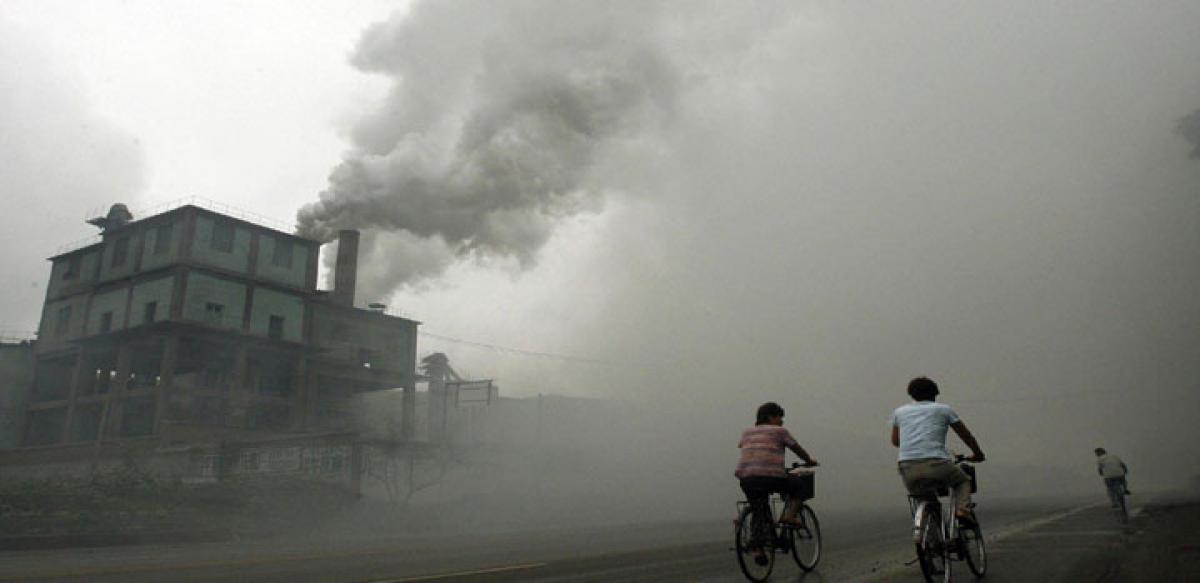Live
- It took me 20 years to reach Sahnkar sir’s ears: Thaman S
- Gaurav Bhatia slams Congress for promising freebies to infiltrators in Jharkhand
- LIC’s entry into health insurance to significantly boost its market share
- Why Covid-19 Vaccine protection wanes over time?
- First Look of Kaliyugam 2064 Unveiled by Mani Ratnam Ahead of Worldwide Release
- Sutraa Indian Fashion Lifestyle Exhibition kicked off at Taj Krishna
- Pokémon TCG Pocket to Introduce Card Trading in January 2025
- Nani unveils ‘MM 2’ title & first look
- Will challenge bail granted to actor Darshan in fan murder case in SC: Bengaluru Police Commissioner
- Chandrahass Launches Maruti Suzuki Dzire Through PJ Productions in Tolichowki Showroom
Just In

With World Health Organisation (WHO) declaring air quality of Indian metropolitan cities worst in the world, healthcare professionals are registering a sharp rise in respiratory problems, especially in the immunocompromised populations like children, elderly and people with health issues or malnutrition.
Amongst the 10 most polluted cities of the world, top four are from India
.jpg)
With World Health Organisation (WHO) declaring air quality of Indian metropolitan cities worst in the world, healthcare professionals are registering a sharp rise in respiratory problems, especially in the immunocompromised populations like children, elderly and people with health issues or malnutrition.
“Air pollution has become one of the major health challenges of the modern Indian cities. With increasing respiratory problems and morbidities, it is now important to raise levels of knowledge around pollutants, outdoor as well as indoor, and their health hazards. It is important to understand that while reducing outdoor air pollution calls for long term and sustained interventions, improving indoor air quality could help reduce total exposure time to the polluted air,” says Dr VV Ramana Prasad ,Consultant Pulmonologist, KIMS Hyderabad.
Several community-based studies have already established a strong link between air pollution and respiratory morbidity and numerous studies have reported an association between indoor air pollution and respiratory morbidity. This not just clearly indicates the importance of putting systems and practices in place that could help improve overall air quality in the metros, but also an urgent need to cut down the sources of indoor air pollution at home.
Commenting on the increasing trend of air purifier, Vijay Kannan, India Head of Blueair says, “Definitely the demand of air purifiers in the cities have increased. With air quality getting extremely poor, people have started realising the importance of ensuring that at least indoor air is breathable. While we have registered an overall increase in the demand in the metros, post Diwali it is like boom in the market. We are hopeful that the technology would not just help people with asthma and other respiratory illnesses, but will contribute in reducing the rate of respiratory diseases in the cities.”
Dr Ramana Prasad says, “In India we have a long standing tradition of burning of incense sticks and dhoop that could increase the concentration of particulate matter (PM) by about 15 times more than the permitted levels. Studies indicate that the smoke emitted by these, releases harmful pollutants. Along with this, smoke from the tobacco and cooking and dust from carpets, furniture and curtains etc further add to the indoor air pollution, which is extremely harmful for the lungs. The situation further worsens after festivals and with the onset of winters, when smog level increases alarmingly.”
The ‘rule of 1000’, emphasised by the report of the World Health Organization (WHO) and cited by the Indian Council of Medical Research (ICMR) Bulletin, states that when a pollutant is released indoors, it is one thousand times more likely to reach people’s lungs than a pollutant released outdoors. Each year, more than 1.6 million people, mainly women and children, die prematurely due to high levels of indoor smoke. Surprisingly, this figure represents approximately twice the estimated mortality due to outdoor pollution.
The best part is people have not just started comprehending the seriousness of the matter, but are also looking for solutions for the same.
“Until sometimes back, people living in metro cities were mostly oblivious to their poor lung functions or Asthma symptoms in children. A major respiratory problem in the family would only raise the alarm. But things have started changing slowly. Maybe because of increasing breathing problems or due to raising awareness, people have now started looking for solutions to the respiratory problems, a recent rise in the demand of air purifier could be a part of this effort,” says Dr. Ramana Prasad.
So while air purifiers are already becoming part of metro-households, it will be interesting to see how the trend catches up with the actual necessity of such technologies in big cities and helps people with prevention of respiratory diseases.

© 2024 Hyderabad Media House Limited/The Hans India. All rights reserved. Powered by hocalwire.com







